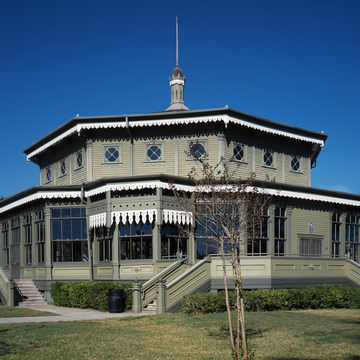The Garten Verein was the late-nineteenth-century version of a country club. It was a pleasure garden, built on what had been the suburban estate of Robert Mills, commission merchant, banker, and sugar planter who had been the largest slaveholder in Texas. Mills's bankruptcy during the Panic of 1873 precipitated the sale of his property, the east half of an outlot, to the Galveston Garten Verein, Galveston's elite German social club. The Garten Verein built this octagonal wood pavilion as its dancing pavilion. Internally, the two-tiered building is open and spacious. Although construction of the dance pavilion was reported in the Galveston Daily News, no architect was ever identified. The building was severely damaged in the Storm of 1900 but reconstructed. In the aftermath of World War I, the Garten Verein dissolved and its property was acquired by Stanley Kempner, who gave the five-acre site to the City of Galveston as a park in honor of his mother, Eliza Seinsheimer Kempner, and in memory of his father, H. Kempner. The dancing pavilion is the only club building remaining on the site. In 1981, it was restored by San Antonio architects Joe Stubblefield and Michael Hilger. At that time, it was repainted in dark, full-bodied colors.
You are here
1880 Garten Verein
If SAH Archipedia has been useful to you, please consider supporting it.
SAH Archipedia tells the story of the United States through its buildings, landscapes, and cities. This freely available resource empowers the public with authoritative knowledge that deepens their understanding and appreciation of the built environment. But the Society of Architectural Historians, which created SAH Archipedia with University of Virginia Press, needs your support to maintain the high-caliber research, writing, photography, cartography, editing, design, and programming that make SAH Archipedia a trusted online resource available to all who value the history of place, heritage tourism, and learning.











